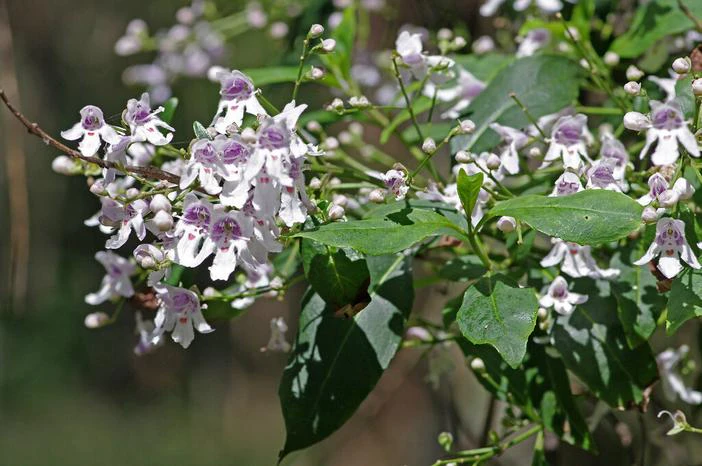Victorian Christmas Bush
(Prostanthera lasianthos)
Victorian Christmas Bush (Prostanthera lasianthos)
/
/

DavidFrancis34
CC BY-SA 2.0
Image By:
DavidFrancis34
Recorded By:
Copyright:
CC BY-SA 2.0
Copyright Notice:
Photo by: DavidFrancis34 | License Type: CC BY-SA 2.0 | License URL: https://creativecommons.org/licenses/by-sa/2.0/ | Uploader: DavidFrancis34 | Publisher: Flickr











































Estimated Native Range
Climate Requirements
| • Precipitation | 36" - 44" |
| • High Temp. | 67°F - 79°F |
| • Low Temp. | 32°F - 42°F |
Summary
Prostanthera lasianthos, commonly known as Victorian Christmas Bush, is an evergreen shrub native to the cool temperate rainforests, sclerophyll forests, and coastal heaths of Eastern Australia. It can grow up to 10 m (35 ft) in height but is typically smaller in gardens. The shrub features large, fragrant, toothed leaves that are 4 to 12 cm long and about 1.5 cm wide, sometimes reaching up to 15 cm. Its flowers are showy, about 2 cm long, and range from white to pale lilac with distinctive purple and orange blotches in the throat. The blooms appear in profuse sprays in late spring and summer, with mauve-flowered shrubs often found at higher altitudes. Flowering occurs in November in the Canberra region, which is earlier than in Victoria.
The Victorian Christmas Bush is valued for its rapid growth, adaptability to a range of soil types, and tolerance of varying light conditions, including heavy shade. It is moderately frost-hardy and can withstand some snowfall. This versatility makes it suitable for use in urban planting, border planting, and as a feature shrub in gardens. It requires low to medium amounts of water and thrives in soils with medium drainage. Pruning can shape the plant and rejuvenate older specimens, preventing them from becoming top-heavy. Cultivars such as ’Kallista Pink’ and ’Mint Ice’ offer gardeners additional ornamental choices with pink flowers and variegated foliage, respectively. ’Liffey Falls’ is another notable cultivar with lilac flowers. Propagation is typically done by seeds or cuttings of firm young growth, although seed viability decreases after three months at room temperature. Suckering may occur, and gardeners should be aware of this potential for spreading.CC BY-SA 4.0
The Victorian Christmas Bush is valued for its rapid growth, adaptability to a range of soil types, and tolerance of varying light conditions, including heavy shade. It is moderately frost-hardy and can withstand some snowfall. This versatility makes it suitable for use in urban planting, border planting, and as a feature shrub in gardens. It requires low to medium amounts of water and thrives in soils with medium drainage. Pruning can shape the plant and rejuvenate older specimens, preventing them from becoming top-heavy. Cultivars such as ’Kallista Pink’ and ’Mint Ice’ offer gardeners additional ornamental choices with pink flowers and variegated foliage, respectively. ’Liffey Falls’ is another notable cultivar with lilac flowers. Propagation is typically done by seeds or cuttings of firm young growth, although seed viability decreases after three months at room temperature. Suckering may occur, and gardeners should be aware of this potential for spreading.CC BY-SA 4.0
Plant Description
- Plant Type: Shrub
- Height: 3-6.5 feet
- Width: 3-6.5 feet
- Growth Rate: Moderate
- Flower Color: White, Purple
- Flowering Season: Spring, Summer
- Leaf Retention: Evergreen
Growth Requirements
- Sun: Full Sun, Part Shade
- Water: Medium
- Drainage: Medium
Common Uses
Bee Garden, Bird Garden, Butterfly Garden, Fragrant, Hummingbird Garden, Low Maintenance, Showy Flowers, Street Planting
Natural Habitat
Cool temperate rainforests, sclerophyll forests, and coastal heaths of Eastern Australia
Other Names
Common Names: Victorian Christmasbush, Mountain-Lilac, Coranderrk
Scientific Names: Prostanthera lasianthos, Prostanthera lasianthos var. subcoriacea
GBIF Accepted Name: Prostanthera lasianthos Labill.